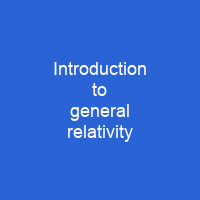General relativity is a theory of gravitation developed by Albert Einstein between 1907 and 1915. It says that the observed gravitational effect between masses results from their warping of spacetime. General relativity also predicts novel effects of gravity, such as gravitational waves, gravitational lensing and an effect of gravity on time known as gravitational time dilation. Many of these predictions have been confirmed by experiment or observation. It provides the foundation for the current understanding of black holes, regions of space where the gravitational effect is strong enough that even light cannot escape.
About Introduction to general relativity in brief
 General relativity is a theory of gravitation developed by Albert Einstein between 1907 and 1915. It says that the observed gravitational effect between masses results from their warping of spacetime. General relativity also predicts novel effects of gravity, such as gravitational waves, gravitational lensing and an effect of gravity on time known as gravitational time dilation. Many of these predictions have been confirmed by experiment or observation, most recently gravitational waves. It provides the foundation for the current understanding of black holes, regions of space where the gravitational effect is strong enough that even light cannot escape. It is also part of the framework of the standard Big Bang model of cosmology. However, a number of open questions remain, the most fundamental of which is how general relativity can be reconciled with the laws of quantum physics to produce a complete and self-consistent theory of quantum gravity. In 1907, Einstein proposed that an object in a gravitational field should feel a force proportional to its mass, as embodied in Newton’s law of gravity. By 1915, Einstein’s theory of general relativity was still the only theory that is consistent with the experimental data. In September 1905, Albert Einstein published his theory of special relativity, which reconciles Newton’s laws of motion with electrodynamics. Special relativity introduced a new framework for all of physics by proposing new concepts of space and time. Some then-accepted physical theories were inconsistent with that framework, which describes the mutual attraction experienced by bodies due to their mass. A person in a free-falling elevator experiences weightlessness; objects either float motionless or drift at constant speed.
General relativity is a theory of gravitation developed by Albert Einstein between 1907 and 1915. It says that the observed gravitational effect between masses results from their warping of spacetime. General relativity also predicts novel effects of gravity, such as gravitational waves, gravitational lensing and an effect of gravity on time known as gravitational time dilation. Many of these predictions have been confirmed by experiment or observation, most recently gravitational waves. It provides the foundation for the current understanding of black holes, regions of space where the gravitational effect is strong enough that even light cannot escape. It is also part of the framework of the standard Big Bang model of cosmology. However, a number of open questions remain, the most fundamental of which is how general relativity can be reconciled with the laws of quantum physics to produce a complete and self-consistent theory of quantum gravity. In 1907, Einstein proposed that an object in a gravitational field should feel a force proportional to its mass, as embodied in Newton’s law of gravity. By 1915, Einstein’s theory of general relativity was still the only theory that is consistent with the experimental data. In September 1905, Albert Einstein published his theory of special relativity, which reconciles Newton’s laws of motion with electrodynamics. Special relativity introduced a new framework for all of physics by proposing new concepts of space and time. Some then-accepted physical theories were inconsistent with that framework, which describes the mutual attraction experienced by bodies due to their mass. A person in a free-falling elevator experiences weightlessness; objects either float motionless or drift at constant speed.
Since everything in the elevator is falling together, no gravitational effect can be observed. In this way, the experiences of an observer in free fall are indistinguishable from those of an observers in deep space, far from any significant source ofgravity. An observer in a closed room cannot tell which of the following is true: Conversely, any effect observed in an accelerated reference frame should also be observed in a Gravitational field of corresponding strength. This principle allowed Einstein to predict several noveleffects of gravity in 1907, as explained in the next section. The apparent magnitude of the fictitious forces always appears to be proportional to the mass of any object on which they act – for instance, the driver’s seat exerts just enough force to accelerate the car at the same rate as the driver at the top of the car. The effect is fundamentally the same as the gravitational field on Earth’s spin, which one can feel if attempting to pull the arms up and out of the top like a top. The principle was formalized in his equivalence principle, which states that a person in an accelerating frame of reference cannot tell that they are in freefall. In the same way, every experiment in such a freefalling environment has the same results as it would for an observer at rest or moving uniformly indeep space. This is why Einstein hypothesized that the similar experiences of weightless observers and inertial observers in special relativity represented a fundamental property of gravity and he made this the cornerstone of his theory.
You want to know more about Introduction to general relativity?
This page is based on the article Introduction to general relativity published in Wikipedia (as of Dec. 06, 2020) and was automatically summarized using artificial intelligence.







